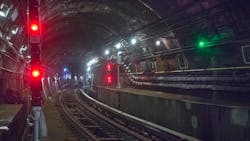MTA takes aim at trespassing incident reduction with new report
The Metropolitan Transportation Authority (MTA) formed a Track Trespassing Task Force in December 2021 designed to be “a multi-pronged approach to protect passengers from the risks of trespassing on the tracks within subway and regional rail systems.”
A new report published by the task force outlines the extent of track intrusions on MTA’s network, as well as several recommendations and actions taken to curb these incidents.
The report found:
- Incidents of track trespass increased 20 percent from 2019 to 2021;
- January 2022 was the peak of the past three years with 160 intrusions, this fell to 100 intrusions in April 2022, but MTA says that number is unacceptable;
- Suicide attempts increased 50 percent through the first quarter of 2022;
- 20 percent of the intrusions during the first four months of 2022 involved people with mental illness;
- Choice was a factor with MTA stating most incidents start with someone choosing to go onto the tracks; and
- In 2021, the average trespassing incident caused a delay of 29 minutes.
“Track intrusion is illegal and incredibly dangerous,” said MTA Chair and CEO Janno Lieber. “This report demonstrates that most instances of track intrusion are done voluntarily by individuals who are not only putting their lives and the lives of transit workers in danger, but also disrupting travel for hundreds of thousands of New Yorkers. The MTA cannot tolerate the status quo and intends to test all available options to prevent these incidents.”
Promoting safe actions typically follows a “three Es” approach – engineering, enforcement and education – and the recommendations included in the task force’s report appear to follow a variation of this approach.
The recommendations included in the report were originally shared with the MTA Board at its February 2022 meeting; they include:
- Customer communications to discourage voluntary acts of track intrusion.
- Operations with coordinated efforts between mental health professionals, homeless outreach workers and law enforcement.
- Capital improvements that utilize technologies to prevent incidents and improve response to those incidents.
“The Track Trespassing Task Force is continuing its work to identify and implement solutions to bring down the number of track intrusions and related injuries and fatalities,” said Jamie Torres-Springer, president of MTA Construction & Development and head of the Track Trespassing Task Force. “This includes high-tech capital projects like Track Intrusion Detection Systems and front-facing cameras on trains, as well as a data-driven partnership with the MTA’s mental health outreach and law enforcement partners, among other efforts. The result will be fewer track intrusions and better responsiveness to those that do occur.”
The full report can be read on the task force’s website.
About the Author
Mass Transit Staff Report
Stories under this byline were produced through a team effort by the editorial staff of Mass Transit.
To learn more about our team, click here.
If you have a story idea, let us know by emailing [email protected]. Please review our contributor guidelines found here.
